::::::::::::::::::::::::::::::::::::::::::::::::::::::::::::::::::::::::::::::::::::::::::::::::::::::::::::::::::::::::::::::::::::::::::::::::::::::::::::::::::::::::::::::::::::::::::::
Akita Folk Art - 秋田県
The capital of the prefecture is Akita 秋田.
Oga Hantoo 男鹿半島 Oga peninsula is famous for its New Year Festival :

. Namahage なまはげ Demons from Oga Hanto .
........................................................................................................................................................

Akitaken, Akita ken, Akita inu 秋田犬 Akita dog toys
Hachiko in front of Shibuya station is a dog from Akita.
- quote -
The Akita (秋田犬 Akita-inu) is a medium breed of dog originating from the mountainous regions of northern Japan.
- - - More in the WIKIPEDIA !
.......................................................................

. Akita no Kokeshi 秋田のこけし .
wooden dolls
Inagawa machi 稲川町, Minasemura 皆瀬村, Yuzawa 湯沢
.......................................................................
. Akitasugi oke taru 秋田杉桶樽 Akita Cedar Cooperage .
.......................................................................
Akita no tako 秋田の凧 kites from Akita
beraboo tako ベラボー凧 with a face sticking out the tongue
from Noshiro 能代市
They have a long tradtion. It is said Sakanoue Tamuramaro used them during the fights with the Emishi in Tohoku. The kite was a sign for the harbour, seen by ships far away.
During the Edo period, they became "fighting kites" in competitions.
. Sakanoue no Tamuramaro 坂上田村麻呂 (758 - 811) .
managu tako まなぐ凧 "kite with big eyes"
painted only with black Chinese ink. managu is the local dialect for manako 目玉 eyeball.
from Yuzawa 湯沢.
It is a kind of the type of Berabo kites, the face of someone doing the アカンベー "akanbee" face. (Japanese facial gesture indicating childish mockery .. It consists of someone pulling down one's lower eyelid to expose the red underside towards someone, often accompanied by the person sticking their tongue out.)
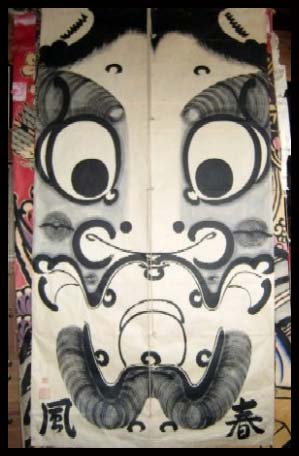
- - - - - and even as a brand-name for sake rice wine:
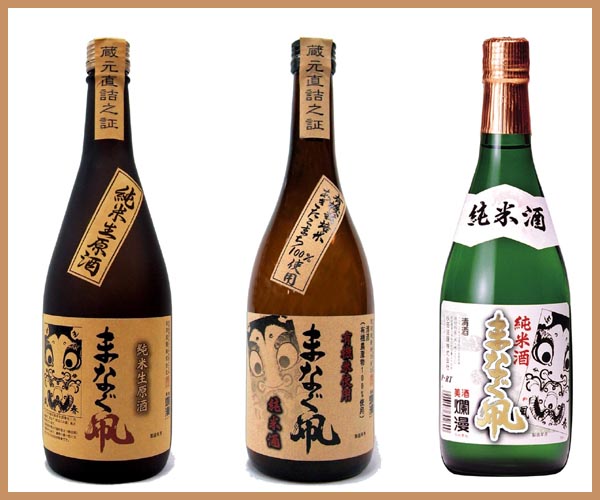
爛漫(秋田銘醸) まなぐ凧シリーズ
..............................................................................................................................................
. Bondeko ぼんでこ fertility stick .
..............................................................................................................................................
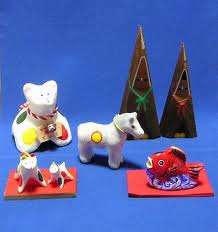
gangu 玩具 new toys from many regions

Yuzawa no inukko 湯沢の犬っこ dogs from Yuzawa
source : akitalife.com
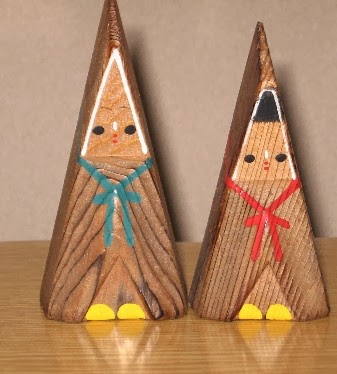
Oodate no o-sugi warabe お杉わらべ children from cedar wood,
from Odate 大館
. magewappa まげわっぱ / 曲げわっぱ Bento Boxes .
from Odate 大館
.......................................................................
gotenmari, goten mari 御殿まり decoration balls
Honjoo 本荘市 - 由利本荘市 Yuri Honjo Town
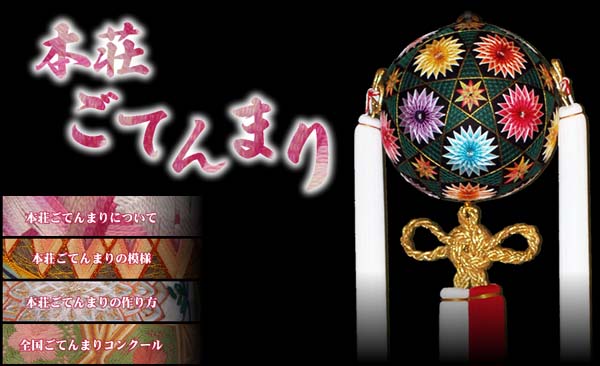
Tassels hanging from three places characterize Honjo Goten-Mari (palace balls), designed with vivid colors and patterns.
In November, a national competition of "goten-mari” is held in the city.
本荘ごてんまりの模様 - extensive Homepage
- reference source : yurihonjo-kanko.jp/special -
. temari 手まり、手毬 "hand ball" rag ball .
.......................................................................
Honjo Sashiko 本荘 刺し子 quilted coat with embroydery
“Sashiko”was originally intended to make fabric stronger and for its extra insulation. However, these days, its practicality and beauty go together after being handed down from generation to generation.
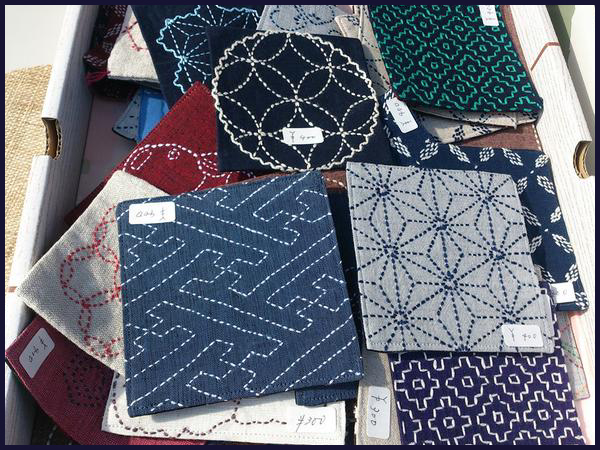
Honjo Kumikozaiku 本荘 組子細工 wooden lattice work decorations
"Kumiko zaiku” (rounded cubic works), made of thousands of “kiriko” (rounded wooden cubes), is an assembly of elaborate skills.
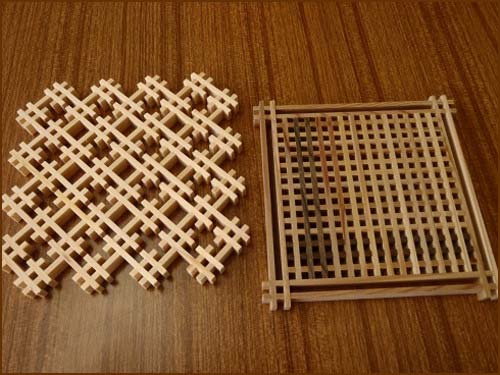
It takes ten years for a craftsman to learn making a finished piece of work.
Honjo Jindaisugi Saiku 本荘 神代杉細工 craft from old cryptomeria trees
天鷺ぜんまい織り Amasagi zenmai-ori weaving / ぜんまい白鳥織 Zenmai-swan weaving or Amasagi Zenmai tsumugi
. . . CLICK here for more Photos !
民芸手染めシリーズ Mingei Tezome hand-dyed goods
- source : en.yurihonjo-kanko.jp/modules -
.......................................................................
kantoo ningyoo 竿灯人形 Kanto dolls
Akita town

. kantoo 竿燈 "lantern on a pole"
Festival on August 3 - 6
........................................................................................................................................................

Kosaka tsuchi ningyoo 小坂土人形 clay dolls from Kosaka town

Once made by Kikuzawa Toozoo 菊沢陶蔵 Kikuzawa Tozo in Arakawa 荒川, near lake Towada.
They are rather simple in their charming ways.

source : blog.nihondorei.com
Kintaro and the Mountain Woman 金太郎と山姥(やまんば)
. - Kintaro 金太郎 "The Golden Boy" Kintoki 金時 .
源頼光と坂田金時 Minamoto Yorimitsu and Sakata Kintoki
........................................................................................................................................................
. Nakayama ningyoo 中山人形 Dolls from Nakayama
.... Nakayama dorei 中山土鈴 clay bells from Nakayama
Nakayama tsuchiningyoo 中山土人形 clay dolls
Nakayama no kushi ko anesama 中山の串コ姉様 - elder sister dolls on a stick
. oiran 花魁 geisha dolls - Nakayama and Yabase .
........................................................................................................................................................
Yokote - Kakunodate 角館町
itaya-zaiku, itayazaiku イタヤ細工 figures from itaya wood
Kakunodate 角館町, Kumoshikari District, Kakunodate, Senboku City.
Made with stripes of bark torn from the Itaya maple tree. The stripes are woven together for items of daily use. When used for a long time, they change color and become beautiful amber color. "It is the customer who creates the art".
itaya kaede, Acer mono Maxim, a kind of maple
- quote -
Itaya craft is one of Akita prefecture designated traditional crafts, which is made in Kumoshikari District, Kakunodate Town, Semboku City.

Their characteristics are lightness, strength, and their color, which will gradually change to beautiful amber over time.
In the making process,
Itaya Kaede (mono maple) is used in the shape of strip and is woven into products by hand. Applying the technique of basket making, products like trays, Tsuzura (box for clothes) and screens are also made and further development of new products are expected.
At this moment, they have developed products made of other materials such as walnut, wild vine, and soil dyed mono maple, which are gaining good reputation.
Manufacturing Processes
The process can be divided into 2 parts. One is making narrow strips from raw wood and the other is weaving.
First,
they slit the material into narrow strips. Their thickness will be less than a millimeter. The careful work of experienced craftsmen will make them into pliant strips with the same width and thickness suitable to each product.
Finally,
the strips will be woven into products by hand.
Mi (an agricultural implement used for threshing) and baskets have been the common products of Itaya craft and they have been commonly used from old times as daily necessities.
History
There are several opinions about its origin, but it seems to have developed from farmers' side job in the winter agricultural off-season.
The district has abounded with materials and been close to consumers in the city. This environment helped Itaya craft flourish.
Kakunodate-machi Itaya Zaiku Kumiai
- source : jtco.or.jp/en/kougeihinkan -
.......................................................................
- quote -
Kabazaiku, kaba zaiku 樺皮細工 / 樺細工 Cherrybark Craftwork
Traditional samurai residences and rows of beautiful cherry trees are a common sight in the city of Kakunodate, Akita prefecture, where one can experience the taste of traditional Japan. Here, Kabazaiku (cherry bark craftwork) has been passed on from generation to generation since the 18th century as a traditional craftwork.

While its name is kaba (or birch), birch is not used in the actual product – the bark of mountain cherry is used. In addition to its naturally beautiful patterns, deep colors, glazing and smoothness, a wide variety of everyday items are made in this style because it lends them durability, moisture prevention and cold protection.
It is believed that the term originally came from the association of white birch or "白樺" with homes in good standing. Thus 樺 may have described the class of artisans rather than the actual materials used.
One aspect of cherry bark is that it does not allow air to pass through it, making it suitable material for tea storing containers.
Kabazaiku in Kakunodate is said to have started when 藤村彦六 Fujimura Hikoroku, a retainer of the Satake (samurai) family which ruled the city during the 1780s, brought in the techniques from the Ani area (current Kita Akita city). Since then, it became a side job of low-class samurai who were taught by the Satake family.
There are two types of kabazaiku – “molded” and “wood-based” –
both of which require extracting mountain cherry bark, drying, cleaning and making it uniform. When “molding,” the cherry bark gets glued to a mold with an adhesive called nikawa, and the mold is removed after is has dried out. In the “wood-base,” style, the already processed cherry bark (with nikawa) gets attached to the product itself, and is then “coated” with kabazaiku, so to speak, using a small metal trowel that has been heated over a fire. Each piece of cherry bark needs to fit the shape of the product, making it extremely time-consuming to complete the process.
In Kakunodate, this craftwork is said to have originated from the production of such items as Inro (small containers used to carry around medicine and other items), which became well known after they were shown on the popular TV series “Mito-Komon”. Later on, the Meiji restoration changed the lifestyle of samurai, who became required to find new ways to make a living. They thus started to get involved with kabazaiku more seriously, and with a more organized and established system of distribution including wholesale activities, the product’s value gradually increased, it came to be presented at expositions and eventually, it was adopted as a gift for the Imperial family.
By the way, you might think that using the bark of trees is harmful to nature, but the bark of mountain cherry trees has the ability to reproduce itself. The “reproduced” bark is called a “second bark”, and can be used for kabazaiku once again. This one art form is a microcosm of the traditional way of thinking of Japanese people, which in the past was focused on co-existing with nature.
- source : japan-brand.jnto.go.jp/crafts/woodcraft -
Betula grossa — Japanese cherry birch
.......................................................................
. oshi-e bina 押し絵雛 hina dolls from raised cloth technique .
........................................................................................................................................................
Tazawa 田沢
. komadaki dooji 駒抱き童子 child holding a horse.
........................................................................................................................................................
Yuzawa 湯沢市 Yuzawa city

shinko saiku しんこ細工 figures made from colored rice dough
shinko is a powder made from new rice, that can be mixed with water to form a dough in the form of animals or flowers. When it is hardened, you can add edible colors for decoration.
The Dog figures are made for the New Year celebrations on January 15, when dogs are honored. (inukko matsuri 犬っ子まつり). Once upon a time, dogs helped drive out a band of robbers from the village. So people build small snow caves and put these animals in there to protect their homes from robbers.
Lately they are only made by one old craftsman, Satoo Masamitsu 佐藤雅三.
..............................................................................................................................................
Yabase tsuchi ningyoo 八橋土人形 clay dolls
Yabase ningyoo 八橋人形 dolls from Yabase
- 八橋 not "yatsuhashi -

団扇持ち娘 girl with a fan, 12 cm high. early Showa period
The clay dolls were made under the influence from Fushimi dolls, brought by merchants on the Kitamaebune 北前舟 trade ships, around 1789 - 1817).
There were quite a few craftsmen producing them at that time, but in the mid-Meiji period, they became almost extinct.
In the Showa period, there were just three families producing them
Takamatsu 高松家、Endoo 遠藤家、Michikawa 道川家
When 高松茂子 died in the first year of Heisei, that was the end.
Now only Michikawa Tomo 道川トモ is left to make them.
Older dolls were made with the basic colors of green and red, since Meiji other colors were also used.

Yabase Tenjin 八橋の天神 Tenjin from Yabase is very popular.
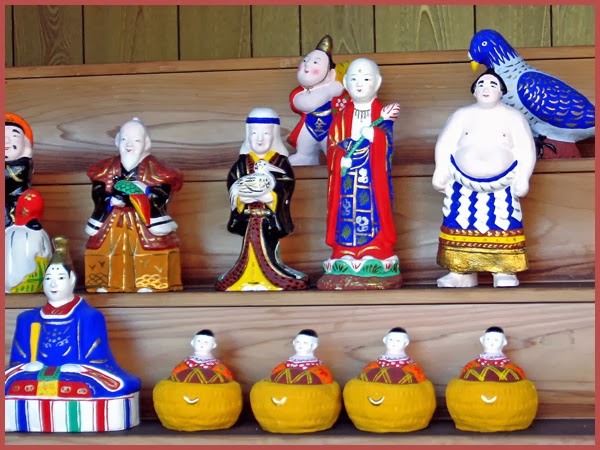

Look at more dolls from Michikawa san :
- source : akitalife.com/gangu
.......................................................................
Yokote Kamakura 横手かまくら snow house from Yokote
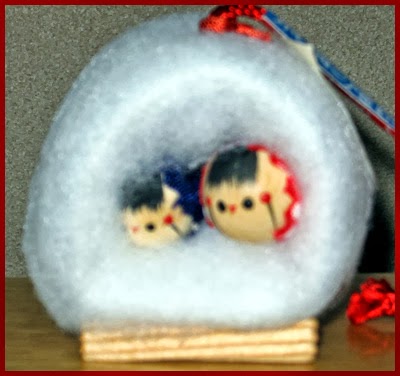
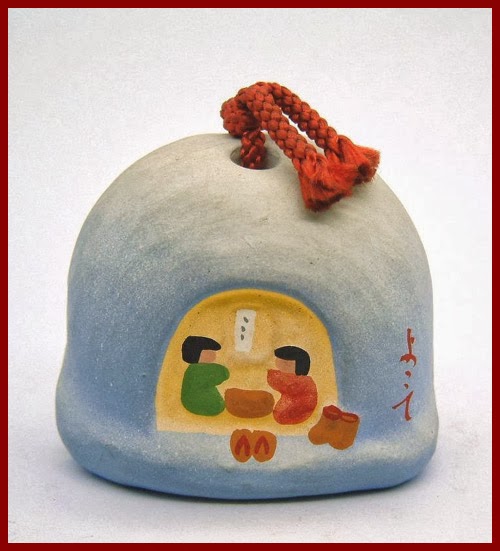
.......................................................................
kezuribana 削り花 flowers from wood shavings
from Yokote town

especially shoobu 菖蒲 iris, but also for other seasonal festivals
::::::::::::::::::::::::::::::::::::::::::::::::::::::::::::::::::::::::::::::::::::::::::::::::::::::::::::::::::::::::::::::::::::::::::::::::::::::::::::::::::::::::::::::::::::::::::::
. Reference and Photos . Gangu Guide .
- reference source : asahi-net.or.jp... Akita -
- source : Sakigake
- source : akitalife.com...
:::::::::::::::::::::::::::::::::::::::::::::::::::::::::::::::::::::::::::::::::::::::::::::::::::::
Gokaku Daruma to enter Akita University
秋田大学 合格だるま
He comes on various goods, from Tee shirts to tea mugs.
. . . . .
. Yuzawa Daruma Onsen 湯沢のだるま温泉 Hot Spring .
::::::::::::::::::::::::::::::::::::::::::::::::::::::::::::::::::::::::::::::::::::::::::::::::::::::::::::::::::::::::::::::::::::::::::::::::::::::::::::::::::::::::::::::::::::::::::::
. WASHOKU . - Regional Dishes from Akita
MORE
. Akita Folk Toys - this BLOG .
. . . . .
. Japan after the BIG earthquake March 11, 2011
[ . BACK to WORLDKIGO . TOP . ]
[ . BACK to DARUMA MUSEUM TOP . ]
- #akita #kakunodate #odate -
::::::::::::::::::::::::::::::::::::::::::::::::::::::::::::::::::::::::::::::::::::::::::::::::::::::::::::::::::::::::::::::::::::::::::::::::::::::::::::::::::::::::::::::::::::::::::::
No comments:
Post a Comment